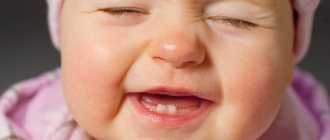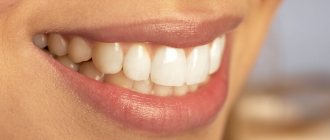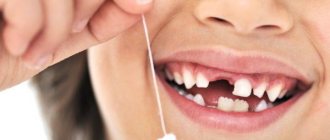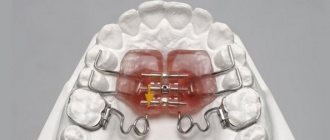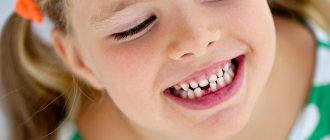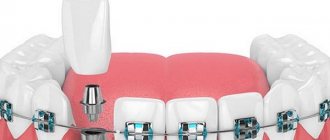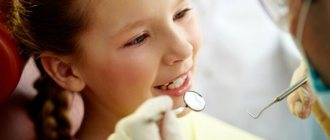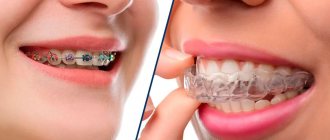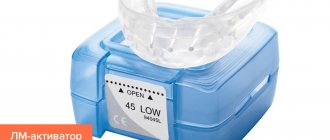The order of eruption of baby teeth
Everyone is different, but it is still important to know how most babies develop. Children's first teeth usually erupt almost simultaneously on the right and left. The sequence is as follows: first the anterior ones (incisors, canines), then the posterior ones.
It is important to understand that this pattern of teething in children is average, and in your case it may happen in a different order or at a different time. This does not necessarily indicate any violations.
Doctors have compiled an approximate, average diagram of teething in children:
Don't worry if you don't meet these standards for several months. If the parents got teeth late, most likely the children will have the same. Heredity has a very strong influence on development. The teething pattern should not become an unnecessary source of parental anxiety. This is just a guideline, like all other norms.
Both the sequence and timing of teething in children can vary greatly. Only if you are “late” by more than 6 months (for example, nothing appears until a year), it is worth discussing this with your doctor. There are genetic disorders when the rudiments of teeth do not develop at all. However, this is extremely rare. Some diseases also affect the timing of teething, but these conditions in children always manifest themselves with some more obvious symptoms.
In any case, there is no remedy that would “cut teeth” - we won’t pull them out of the jaw. We also do not regulate the cutting order. All that remains is to observe the process in children and take care of their health in general.
Modern terms of formation of temporary and permanent occlusion in children
Teething has a significant impact on the formation of a child’s body and is an indicator of the child’s overall development. With the eruption of primary teeth, the process of eating is transformed: the sucking reflex fades, the mechanism of the act of swallowing changes, and the chewing function begins to form. Developing active chewing promotes jaw growth and changes in the proportions of the brain and facial skull.
Speech development is activated—correct articulation and sound production become possible, which is an integral part of social adaptation and stimulation of the child’s mental development. The physiological norm for the eruption of teeth in the primary dentition can be established based on a number of criteria, such as certain timing, pairing and sequence of eruption [7, 13, 18].
The delay in the eruption of primary teeth, according to domestic and foreign literature, may be due to prematurity, the negative influence of the pathology of the neonatal and postnatal periods of child development [10, 25, 31, 35, 36].
A number of authors note the negative impact of rickets on the physiological course of the eruption of primary teeth. According to N.I. Agapov (1953), the consequences of rickets affect the condition of the upper and lower jaws differently, which contributes to the disruption of the sequence and pairing of the eruption of primary teeth [1]. L.V. Ilyina-Markosyan (1961), in a histological study of the microstructure of the jaw bones in rickets, concluded that the delay in eruption can be explained by a violation of the bone structure of the jaws. These disorders manifest themselves as deposition of osteoid tissue along the periphery of the bone beams, and in some areas as more extensive accumulations of osteoid, which is slowly resorbed. The author believed that the violation of the eruption sequence was due to delayed growth of the lower jaw. As a result, temporary teeth first erupt on the upper jaw, and only then on the lower jaw. Rickets suffered during the first year of a child’s life has a pronounced effect on the timing of the eruption of primary teeth and leads to their delay by 4-5 months. compared to healthy children. In the group of children with rickets, all signs of physiological eruption of primary teeth were disrupted: timing, pairing and sequence [12]. In addition, the timing of the eruption of primary teeth is directly influenced by the type of feeding in infancy and the characteristics of the introduction of subsequent complementary foods, which shape the nature of the chewing load in the future. Early eruption of primary teeth was noted in breastfed children, in comparison with the group of children on artificial and mixed feeding [7].
Dysfunction of the endocrine glands has a negative impact on the formation of the dentofacial apparatus and, in particular, on the process of teething. Thus, with hypothyroidism and hypoparathyroidism, there is a discrepancy between the stage of formation of teeth, jaw bones and the age of the child. Clinically, there is a delay in the eruption of temporary teeth by 1-3 years, the period of their replacement with permanent teeth is delayed by 3-4 years [4, 17, 23]. Osteoporosis and deformations of the jaw bones, adentia, enamel hypoplasia, atypical shapes of tooth crowns and a decrease in their size are observed [17, 21]. With hyperthyroidism, along with changes in the morphological structure of the teeth, dentition and jaws, the work of the masticatory muscles and tongue muscles is disrupted, which together leads to impaired closure of the dentition and earlier teething [23].
In the modern generation of healthy children, the eruption of primary teeth is observed earlier than the generally accepted period, by an average of 1-2 months, which is associated with the urbanization of the population and the global acceleration of human development. The consequence of early eruption of primary teeth in children is the high intensity of the carious process due to insufficient mineralization of hard dental tissues [10, 11].
Knowledge of the timing and patterns of eruption of primary teeth, taking into account the significant role of this process in the formation of the child’s body, can be a diagnostic and prognostic sign of a number of diseases, a criterion for choosing the quality and quantity of complementary foods during the child’s transition to solid food, and a basis for determining the timing of preventive and therapeutic manipulations in dentistry and speech therapy. Nevertheless, the information provided about the timing of the eruption of primary teeth in the domestic reference, educational and scientific literature is contradictory (Table No. 1), which is due to the climatic and geographical zones of the research. In the territory of the Krasnoyarsk Territory and Krasnoyarsk, such studies were of a single, episodic nature [24].
Table No. 1. Timing of eruption of primary teeth according to various authors
Author / year | Timing of teething, months. | |||||||||
51 | 61 | 52 | 62 | 53 | 63 | 54 | 64 | 55 | 65 | |
81 | 71 | 82 | 72 | 83 | 73 | 84 | 74 | 85 | 75 | |
| V. Shpaltegolts (1909) | 7–8 | 8–12 | 16–20 | 12–16 | 20–30 | |||||
| D. A. Kalvelis (1965) | 6–8 | 8–12 | 16–20 | 12–16 | 20–30 | |||||
| V. Yu. Kurlyandsky (1970) | 6–7,5 | 7–9 | 16–18 | 12–14 | 20–24 | |||||
| A. A. Kolesov (1991) | 6–8 | 8–12 | 16–20 | 12–16 | 20–30 | |||||
| L. S. Persin (1984, 1999, 2006) | 6–8 | 8–12 | 16–20 | 12–16 | 20–30 | |||||
| V. L. Bykov (1998) | 6–8 | 8–12 | 14–20 | 12–16 | 20–30 | |||||
| M. R. Sapin and Z. G. Bryksina (2000) | 6–8 | 7–9 | 16–20 | 12–15 | 20–24 | |||||
| R. E. McDonald and D. R. Avery (2003) | 6–7,5 | 7–9 | 16–18 | 12–14 | 20–24 | |||||
| C. V. Gaivorovsky (2003) | 6–8 | 8–12 | 18–20 | 12–15 | 20–24 | |||||
| M. P. Vodolatsky (2004) | 6–8 | 8–12 | 16–20 | 12–16 | 20–30 | |||||
| O. E. Tkachuk (2006) | 6–12 | 6–12 | 24 | 18 | 30–36 | |||||
| L. L. Kolesnikova and S. S. Mikhailova (2006) | 6–7,5 | 7–9 | 16–18 | 12–14 | 20–24 | |||||
| E. Yu. Simanovskaya (2007) | 6–8 | 7–12 | 16–20 | 12–16 | 20–30 | |||||
| M. G. Prives and N. K. Vasenkov (2009) | 6–8 | 7–9 | 10–20 | 12–15 | 20–24 | |||||
The timing of the eruption of permanent teeth during the physiological development of the child coincides with the timing of complete resorption of the roots of temporary teeth. These processes are associated with the growth and development of the human dentofacial apparatus. Information about the age-related characteristics of the eruption of permanent teeth allows one to judge the general level of physical development and the state of health of the child’s body [26].
R. Almonaitiene, I. Balciuniene and J. Tutkuviene (2010) conducted a detailed analysis of the factors influencing the process of permanent dentition formation. The authors note a more significant relationship between the timing of the eruption of permanent teeth and systemic diseases; genetic factors, gender, constitutional characteristics and socio-economic factors are considered less significant [32]. A. Must et al. (2012), as a result of a long-term survey of US schoolchildren, conclude that there is a relationship between lipid metabolism disorders and the processes of sexual development in children based on the stimulating effect they identified of obesity on the eruption of permanent teeth and the rate of formation of permanent dentition [34]. A paradoxical pattern was revealed by V. Harila-Kaera, T. Heikkinen and L. Alvesalo (2003) when studying the relationship between the timing of the eruption of permanent teeth and the degree of prematurity in children. The results of their study revealed significantly (P<0.05) earlier timing of eruption of the first permanent molars and incisors in the group of children born preterm. This fact leads the authors to believe that the process of eruption of those teeth occurs at an earlier stage, the histogenesis and the beginning of mineralization of which occur in the difficult perinatal period, under the influence of various systemic factors and the phenomenon of catch-up growth [33]. Recently, a few studies have been carried out (mainly within the framework of anthropology) concerning the biological age of a person [5, 27]. For preschool and primary school age, the most informative criteria of biological development are the timing of the eruption of permanent teeth and the dynamics of increasing the height of the clinical crown. The indicator of dental maturity, along with skeletal maturity, more accurately reflects the process of physiological maturation of the body than chronological age. A close relationship has been found between the processes of ossification of the skeleton and teething. At the same time, observation of dental eruption is a non-invasive and economically more feasible procedure in comparison with the x-ray method of examination, which allows identifying many markers of general developmental disorders [14, 26].
The reference, educational, methodological and scientific literature provides conflicting information about the timing of the eruption of permanent teeth (Table No. 2). The reason for this is the peculiarities of the course of this physiological process depending on the climatic and geographical conditions in the research areas [14].
Table No. 2. Timing of eruption of permanent teeth according to various authors
Author / year | Timing of teething, years | |||||||||||||
11 | 21 | 12 | 22 | 13 | 23 | 14 | 24 | 15 | 25 | 16 | 26 | 17 | 27 | |
41 | 31 | 42 | 32 | 43 | 33 | 44 | 34 | 45 | 35 | 46 | 36 | 47 | 37 | |
| D. A. Kalvelis (1965) | 6 –9 | 7 –10 | 9 –14 | 9 –13 | 10 –14 | 5 –8 | 11 –14 | |||||||
| V. Yu. Kurlyandsky (1970) | 6 –8 | 7 –9 | 9 –12 | 10 –12 | 10 –12 | 6 –7 | 11 –13 | |||||||
| T. F. Vinogradova (1982) | 5 –6 | 7 –9 | 12 –13 | 9 –11 | 9 –11 | 4,5 –7 | 12 –13 | |||||||
| L. S. Persin (1984, 1999) | 7 –8 | 8 –9 | 10 –12 | 9 –11 | 11 –13 | 6 –7 | 12 –13 | |||||||
| A. A. Kolesov (1985, 1991) | 6 –8 | 8 –9 | 9 –11 | 9 –10 | 11 –12 | 6 | 12 –13 | |||||||
| T. V. Sharova and G. I. Rogozhnikov (1991) | 7 –7,5 | 8 –9 | 10 –13 | 9 –11 | 12 –14 | 6 –6,5 | 11 –13 | |||||||
| V. L. Bykov (1998) | 7 –8 | 8–9 | 12–13 | 9–11 | 11–12 | 6–7 | 12–13 | |||||||
| M. R. Sapin and Z. G. Bryksina (2000) | 6 –8 | 7–9 | 9–12 | 10–12 | 10–12 | 6–7 | 11–13 | |||||||
| V. G. Khatskevich and I. A. Bogomolova (2002, 2004) | 6–9 | 6–10 | 7–13 | 7–13 | 7–14 | 6–8 | 8–15 | |||||||
| M. R. Sapin and G. L. Bilich (2001, 2008) | 7–8 | 9–10 | 11–12 | 9–10 | 9–11 | 6–7,5 | 11–12 | |||||||
| N. A. Matveeva (2002, 2007) | 6 | 7–8 | 11 | 10 | 11 | 6 | 12–13 | |||||||
| P. A. Zhelezny (2003) | 4,5–7 | 5–8 | 7–12 | 7–12 | 9–12,5 | 4,5–7 | 8–13 | |||||||
| M. P. Vodolatsky (2004) | 6–8 | 8–9 | 10–11 | 9–10 | 11–12 | 6–8 | 12–13 | |||||||
| O. E. Tkachuk (2006) | 7 | 8 | 10 | 9 | 11 | 6 | 12 | |||||||
| L. S. Persin and V. M. Elizarova (2006) | 6–8 | 8–9 | 9–10 | 11–12 | 11–12 | 6 | 12–13 | |||||||
| L. L. Kolesnikova and S. S. Mikhailova (2006) | 6–8 | 7–9 | 9–12 | 9–11 | 11–12 | 5–8 | 11–13 | |||||||
| E. N. Polosukhina (2007) | 6–7 | 7,5 | 10 | 10 | 11 | 6 | 12 | |||||||
| E. Yu. Simanovskaya (2007) | 7–8 | 8–9 | 10–13 | 9–10 | 11–12 | 5–6 | 12–13 | |||||||
| M. G. Gain and N. K. Vasenkov (2009) | 8 | 9 | 11–13 | 10 | 11–15 | 6–7 | 13–16 | |||||||
A few publications provide a more detailed analysis of the timing of the eruption of upper and lower permanent teeth depending on the sex of the child. At the same time, earlier eruption of permanent teeth in girls is noted [3, 10]. However, these data were obtained in different years when analyzing different populations of children in the CIS countries with different ethnic composition and living standards. In Russia, studies, the results of which formed the basis for determining the rate of eruption of permanent teeth, were conducted in the southern and central regions of the country, while similar data in Siberia and the Far East were not taken into account.
N. G. Rusina (2000) studied in the Krasnoyarsk Territory the anthropogenic features of the change of temporary teeth, the order and timing of the eruption of permanent teeth in children [23]. At the same time, over the past years, the structure and composition of the population in this territory has changed due to significant migration activity, the technogenic impact on nature has increased, and the climatic conditions of living have changed.
Thus, the need to use more precise timing for the eruption of primary and permanent teeth in children is currently being determined.
Materials and research methods
In order to establish the actual timing of the eruption of temporary and permanent teeth in children and adolescents in modern conditions, a dental examination of 1447 apparently healthy children aged 5 to 28 months was carried out. and 1058 apparently healthy children aged 4 to 13 years. The subjects were divided into groups according to gender and age with a range of 1 month. and 1 year respectively. To ensure the representativeness of the study results, the number of observations in each age and sex group was at least 30 people. Additionally, 267 schoolchildren underwent dynamic observation of the rate of increase in the height of the clinical crown of permanent dentition teeth.
Dental examinations of children were carried out by random sampling in outpatient clinics, preschool and school educational institutions of Krasnoyarsk.
The physiological norm of teeth eruption of temporary and permanent dentition was determined based on a number of criteria, such as certain timing, pairing and sequence of eruption. To establish the timing of tooth eruption, the following provisions were used in the literature: 1) the beginning of eruption was considered the moment of perforation of the alveolar gum by a tooth with exposure of one cusp or incisal edge [20]; 2) the average age of tooth eruption is considered to be the age when 50% of those examined have this tooth [2].
However, in view of individual differences in the rates of growth and development of modern children, in our opinion, it is more rational to designate the age ranges in which the eruption of certain teeth occurs. In this case, the initial boundary of the teething interval is the age at which 5% of the studied children have a given erupted tooth, and the end is the age when 95% of the examined children have this tooth [2].
As a result of the study, it was revealed that the order and timing of the eruption of primary teeth on the right and left are the same, which confirms the position of symmetrical eruption.
Based on a certain frequency of eruption of primary teeth in age and sex groups, the timing of eruption of primary teeth in children in Krasnoyarsk was calculated in the form of age ranges, which are presented in Table No. 3.
Table No. 3. Age ranges for the eruption of primary teeth in children in Krasnoyarsk
Jaw | Floor | Timing of teeth eruption of temporary occlusion (age, months) | |||||||||
51 | 61 | 52 | 62 | 53 | 63 | 54 | 64 | 55 | 65 | ||
81 | 71 | 82 | 72 | 83 | 73 | 84 | 74 | 85 | 75 | ||
| top | boys | 7–11 | 7–13 | 15–22 | 11–17 | 20–27 | |||||
| girls | 6–9 | 7–12 | 14–21 | 11–16 | 19–27 | ||||||
| lower | boys | 6–9 | 8–13 | 15–22 | 12–17 | 19–26 | |||||
| girls | 5–8 | 8–13 | 15–21 | 12–16 | 19–26 | ||||||
From the data presented in Table No. 3, it follows that there are gender differences in the timing of the eruption of primary teeth, characterized by a tendency for earlier eruption in girls (on average by 1 month), as well as differences in the order of appearance of teeth on the upper and lower jaws, which are mosaic character.
The following sequence of eruption of primary teeth was noted: teeth 71 and 81 erupt first, then 51 and 61; 52 and 62; 72 and 82; 54 and 64; 74 and 84; 53, 63 and 73, 83; 75 and 85; 55 and 65.
The indicated timing of the eruption of temporary teeth has features in comparison with the information in the domestic literature - the beginning of the eruption of temporary teeth occurs at an earlier age, in contrast to the data given in classical textbooks (Table No. 1).
At the same time, in comparison with the results of modern studies conducted in the central territories of Russia [10], a later start of eruption of primary teeth was noted in children in Krasnoyarsk. Data characterizing the process of teeth eruption in permanent dentition indicated a symmetrical, pairwise eruption of permanent teeth in children. A certain frequency of eruption of permanent teeth made it possible to calculate the average time for the eruption of permanent teeth in children in Krasnoyarsk in the form of age ranges, which are presented in Table No. 4.
Table No. 4. Age ranges for the eruption of permanent teeth in children in Krasnoyarsk
top | boys | 5–8 | 7–9 | 9–13 | 7–11 | 8–12 | 4–7 | 10–13 |
girls | 5–8 | 6–9 | 9–12 | 7–11 | 8–12 | 4–7 | 10–13 | |
lower | boys | 4–7 | 5–8 | 8–12 | 8–11 | 8–12 | 4–7 | 10–13 |
girls | 4–7 | 5–8 | 8–11 | 8–11 | 8–12 | 4–7 | 9–13 |
From the data presented in Table No. 4, it is clear that there were differences in the sequence of teeth eruption on the lower and upper jaws. So, on the lower jaw, teeth 31, 41 and 36, 46 erupt simultaneously, and on the upper jaw in children, the eruption of permanent teeth begins with teeth 16, 26. In addition, on the lower jaw the canines erupted after the first premolars, and on the upper jaw - after the second premolars. The following sequence of eruption of permanent teeth on the upper jaw is noted: teeth 16 and 26 erupt first, then 11 and 21; 12 and 22; 14 and 24; 15 and 25; 13 and 23; 17 and 27. On the lower jaw, a similar physiological process looked like this: 36, 46 and 31, 41; 32 and 42; 34 and 44; 33 and 43; 35 and 45; 37 and 47. The presented results regarding the sequence of eruption of permanent teeth are consistent with the data of L. B. Leporskaya and E. V. Udovitskaya (1978) [16]. Gender differences were noted in the timing of the eruption of permanent teeth, which are characterized by the fact that girls showed a tendency towards earlier eruption, on average by 6-12 months. The results of dynamic observation of the increase in the height of the clinical crown showed that the period of eruption of each tooth to correspond to the height of the clinical crown height of the anatomical crown takes a long period of time. For central incisors and first molars it was 2.5 years, for lateral incisors - 3 years, for canines, premolars and second molars - 4 years. The data obtained do not agree with the results of a study published by E. I. Goncharova (1976), who determined longer time periods of 1.5 or more years [8]. The intensity of teething in girls is significantly higher than in boys. The results obtained regarding the timing of the eruption of permanent teeth differ from the data given in modern domestic literature, determining regional characteristics and consisting in an earlier formation of permanent dentition by an average of 12 months. Thus, the age-sex and regional characteristics of the eruption of primary teeth consist in the relatively early formation of a temporary occlusion in children in Krasnoyarsk and the advance in the timing of the eruption of primary teeth in girls. These circumstances justify the need to revise organizational technologies for the implementation of caries prevention programs in primary teeth at an earlier date due to insufficient mineralization of their hard tissues.
The study of age-sex and regional characteristics of the eruption of permanent teeth showed a relatively early formation of permanent occlusion in children in Krasnoyarsk and an advance in the timing of the eruption of permanent teeth in girls. These circumstances must be taken into account when determining the biological maturity and general development of the child, to develop age criteria for justifying the feasibility of preventive dental prosthetics in the case of early removal of temporary teeth, during upcoming orthodontic treatment and predicting its results, as well as when planning and implementing schemes and measures of existing prevention programs main dental diseases among the child population.
Literature
- Agapov N. I. Clinical dentistry of children / N. I. Agapov. - M.: Medicine, 1953. - 258 p.
- V. Belyakov Yu. A. Dentofacial system in endocrine diseases / Yu. A. Belyakov. - M.: Medicine, 1983. - 208 p.
- Bogomolova E. S. Modern trends in the growth and development of schoolchildren in Nizhny Novgorod / E. S. Bogomolova, N. A. Matveeva, A. V. Leonov // Almanac “New Research”. - M., 2004. - No. 2. - P. 85-86.
- Bykov V. L. Histology and embryology of human oral cavity organs (2nd ed., revised) / V. L. Bykov. - SPb.: Special. lit., 1998. - 247 p.
A complete list of references is in the editorial office.
What problems may arise during teething in infants?
Difficulties do not always arise. But sometimes, about 3 days before and 3 days after teething, the baby’s condition changes:
- gums swell;
- saliva flows more strongly (although a lot of it can be released without connection with teething);
- the temperature rises slightly;
- mood deteriorates (child is less active, cries more often);
- sleep becomes restless;
- stools become slightly looser and more frequent;
- your cheeks turn slightly red (no need to immediately look for allergens and change your diet).
These symptoms may not all appear, in any combination.
The difficulty is that the same symptoms, but usually stronger, can also occur in children with infections. Therefore, if your condition has changed significantly, consult your doctor.
Red flags (tell your doctor if your child has):
- temperature above 38 degrees in the absence of cold symptoms;
- a rash that is unfamiliar to you, which appeared along with a high fever;
- diarrhea, vomiting;
- lethargy;
- mouth ulcers or other sores.
- Eruption cyst (hematoma).
Assess how much the child's condition has changed. If he begins to clearly feel unwell, there is no need to attribute this to the teething of baby teeth. In this case, you need a doctor to rule out more serious problems.
Teething
The emergence of permanent teeth from the place of origin and development into the oral cavity, provided that the child develops correctly, coincides with the period of loss of milk teeth. As a rule, replacement occurs in the same sequence as eruption during the formation of a temporary bite.
The first permanent teeth appear between 5 and 6 years of age. These are the first permanent molars that have no temporary predecessors. They are the first to undergo the process of calcification of hard tissues after the birth of a child. After this, premolars, second molars, central and lateral incisors, and canines appear.
If there are problems with resorption of temporary roots and other difficulties that prevent normal eruption, a baby tooth is removed and other dental care is provided. This takes into account the fact of genetic predisposition and other features of the child’s development.
According to WHO, the standard terms of development and eruption are:
- Central incisors. Mineralizes at 4-5 years of life. They appear in the mouth at 6-8 years of age, while root formation is completed only by 10 years of age.
- Lateral incisors . They erupt at the age of 8-9 years. Complete mineralization of the enamel occurs at 4-5 years of a child’s life, and the root system continues to develop up to 10 years;
- Fangs . Enamel mineralizes at 6-7 years of age. They emerge in place of temporary ones at 10-11 years of age and complete full formation at 13 years of age.
- First premolars. They undergo complete mineralization at the age of 5-6 years and appear in the mouth at 9-10 years. The root system of these teeth is formed by the age of 12.
- Second premolars . Mineralizes by 6-7 years. They usually erupt at the age of 11 years and complete development by 12 years.
- First molars . They are the very first permanent teeth. They mineralize at 2-3 years, erupt at 5-6 years and are fully formed by 10 years.
- Second molars . They appear in children at the age of 12-13 and complete development by the age of 15. Moreover, their intramaxillary growth and mineralization takes place in the period of 7-8 years.
The last permanent teeth to appear between the ages of 18 and 25 are the third molars. Their final development can last up to 30 years.
Medicines for teething in children
When your baby is in pain, you would like to have a reliable, effective medicine that you can give and sleep peacefully. As in the case of colic, when teething, the pharmacy will offer you a variety of remedies. Pediatric experts do not advise giving any medications without a doctor's permission.
Why? Homeopathic medicines are divided into true homeopathic (containing no active substance at all, and therefore ineffective) or pseudo-homeopathic. The latter contain some amount of plant components (usually chamomile and other, more exotic plants). The first ones do not work under any conditions, including teething in children, but at least they are harmless. Homeopathic remedies for pain containing belladonna (which was not even always listed in the composition) caused many deaths and were therefore strictly prohibited in developed countries.
In our country, the Commission of the Russian Academy of Sciences recognized homeopathy as a pseudoscience, but, unfortunately, there is no strict ban on potentially dangerous drugs. Since manufacturers do not always indicate belladonna in the composition, we recommend that you generally refrain from using any homeopathic remedies for teething pain in children.
Another case is gels with a local anesthetic drug (their name ends in “-caine”: usually benzocaine or lidocaine). Medicines like these are “freezes” that are injected into the gums when treating teeth. Although these drugs are obviously effective, they have also caused many child deaths. Substances of this group affect the functioning of the heart, because the gel is quickly washed off with saliva, and the child swallows it. It is especially dangerous if the parent uses a higher dose than recommended in the instructions. This happens often because these drugs only relieve pain for a few minutes. When the baby starts crying again, the parents apply more, often exceeding the dose. Now professional communities of doctors do not recommend the use of products with local anesthetics, but this does not stop their widespread advertising.
Symptoms by which you can determine that your baby is cutting his first teeth
As a rule, an event such as teething does not go unnoticed by parents, as it is accompanied by many symptoms, including pain and severe itching of the gums in the place where the tooth cuts. Due to this, the child may even refuse to eat. In addition, body temperature may increase (but no more than 38° and no longer than 3 days), stools may change (become more liquid, but not to the consistency of water), salivation will increase, and sleep will be disturbed. 3 – 5 days before the tooth appears, the gums swell a little and turn red. After the tooth appears on the surface, all symptoms subside.
What to do when children are teething?
The most natural and one of the most reliable ways to reduce pain is cold. Pick up an item - a “rodent” that can be put in the refrigerator. Freezing them is not recommended because it can damage the baby's delicate gums.
Often children prefer to gnaw on their parent's finger or, unfortunately, on their mother's breast. But parents may not have enough patience for a long time, so it is better to find a suitable teether.
It should be:
- whole and durable (the child should not bite off pieces that could cause choking);
- without ropes and beads (the rope can pinch the neck or break, creating a risk of choking on a bead);
- without paint with toxic components;
- just clean (no need to disinfect it).
You can refrigerate the fruit puree or put a few wet cloth toys in the refrigerator so you can replace them.
Of course, children chew not only objects that are ideal for this. But if with a teether made of one piece of silicone or a mitten with a silicone pad the child can be left alone in the playpen for some time, then with a bunch of small objects on a string around the neck or a bracelet made of beads, the same as with some fruit or vegetable, you need to look after it.
If cooling does not help, and the stress of teething is very severe, discuss taking pain relievers and fever reducers (ibuprofen is most often used) with your pediatrician. To be on the safe side, consult your doctor, but a single dose by weight (for ibuprofen is 10 mg/kg), given once at night for 3-4 days of active teething, will not cause harm.
What does a dental formula look like?
To make it more convenient to describe teeth and their number, special formulas are usually used. Each tooth has its own number, which is used to decipher its location.
When describing a milk bite, Roman numerals are used:
- incisors – I, II;
- canine – III;
- molars – IV, V.
If we talk about the formula for adult teeth, here the teeth are counted starting from the center:
- incisors – 1.2;
- fang – 3;
- molars (small) – 4.5;
- molars (large) – 6,7,8.
8 is a wisdom tooth; not every person has it.
Should I brush my newly erupted teeth?
Dentists strongly recommend starting to take care of oral hygiene from infancy. For newly emerging teeth, they offer special silicone brushes or wipes. A simpler option is a finger wrapped in gauze. You can simply moisten it with water or use toothpastes for children under 3 years of age (they are marked 0+ and can always be swallowed). The main thing when brushing your teeth is no violence! A little more cleanliness isn't worth the stress.
| Author Fedor Katasonov | Scientific editor Maria Gantman |
Caring for baby teeth
As soon as your first tooth comes through, don’t put off going to the dentist. Make a schedule of visits (at least once every 3-4 months). And after the first birthday, it is advisable to also see an orthodontist. If there are no problems, visits to him should be repeated once a year [7,8]
It is important to provide proper care at home.
- An ultra-soft toothbrush with a small head is suitable for baby teeth
- Children's mouth rinses are used from about 4 years of age or from the time the child learns to spit out liquid.
- Parents should supervise the brushing of preschool children's teeth and, if necessary, help and finish cleaning missed areas.
- Adults need to teach their child to rinse their mouth after eating from a very early age.
- Until the child has learned to spit on his own, toothpaste should not contain fluoride.
- A timer in the bathroom or a favorite song helps you keep your teeth brushing to 2 minutes.
- Solid food should be included in the diet daily in sufficient quantities to properly form the bite and stimulate the gums.
These simple recommendations help maintain the health of baby teeth from the very beginning until their natural replacement with permanent ones.
